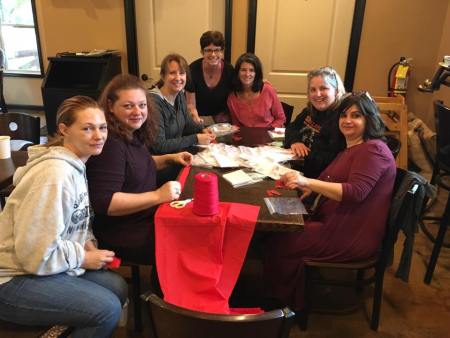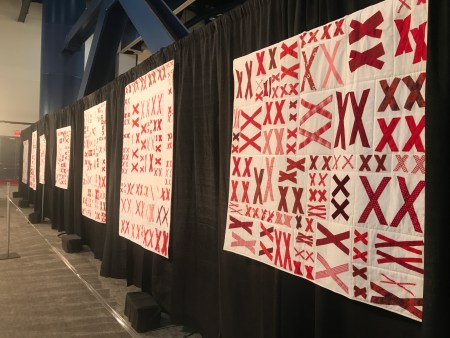




It is her pocketbook that first catches my eye. I like ’em big, self reliant (willing and able to stand on their own when put down), and open at the top so I can reach and retrieve efficiently. Hers meets all my criteria, and I don’t mind telling you that I covet it.
“Is that your grandson?” she asks, stopping about 8′ away from us where The Engineer stands holding our grandson, Calder Ray.
I nod.
“He’s adorable,” she says.
“I know,” I tell her. “And if I didn’t say that, I’d have to turn in my grandparents’ card. Do you have grandchildren?”
“Not yet,” she says then asks, “but would you like to see what I’m doing for my future grandchildren?”
I follow her to a nearby bench and sit beside her. From her magic bag, she pulls out a large sketchbook. It’s the sixth one she’s created for her future grandchild, each filled with stories sketched around a central theme. This book is a treasure hunt to all her favorite places on Hilton Head Island where she lives. She shows me the sketch she’s working on now, a map to the place she goes to see the best sunsets on the island. (A place I’ve never heard of. A place we will visit the following night.)
After asking if I can copy her idea that, as a personal and family historian, I am now totally smitten with and committed to despite my woeful lack of drawing skills, I ask about the theme of the other 5 journals. She tells me that the first one was about her family history. She tells me about how during World War II her ancestors did what so many families in Holland did at that time: delivered their young boys to a cruise ship and left them there, knowing that their sons would be fed, clothed, and trained for a career. Her uncle spent the rest of his life with that cruise line.
“I didn’t know how much to write about that particular period of time,” she confesses, “because while I want to tell the truth, I don’t want these books to be dark. My family hid in the attic of their house and slaughtered goats up there for food. It was not an easy or pretty life back then.”
“So true. Would you like to hear what I’m working on?” I ask, then I tell her the thumbnail version of The 70273 Project. She listens intently then asks, “What would you do if I told you that Nazis are live and well today – even right here on Hilton Head Island?”
“I don’t know exactly what I’d do,” I answer, “but I’d do something.”
I regret my answer the second the period at the end of the sentence falls out of my mouth, and I tell her so. “You ask a very good question, and it begs a better, more thoughtful answer – especially since one of the 3 purposes of The 70273 Project is to educate all who will listen not just about the atrocity, but about things like respecting differences, protecting those who can’t protect themselves, and about taking a stand against bullying. Thank you for the good question. You’ve given me something to think about, sort out, and articulate.”
She tells me that Nazis are alive and well today, and that some are stalking and persecuting her because she calls them out publicly. Some, she assures me, are well-placed elected officials. She encourages me to go to the local courthouse and pay them $10 for a cd version of the transcript of her latest trip to court that happened just the week before. She tells me more about what’s happening in her life and who these well-placed people are, and when I notice the family looking at me and tapping their watches, I tell her it’s time for me to go. “Remember to get that transcript if you have time,” she implores me, “and at the very least, remember that they still exist.”
Though she cautions me to ponder all she told me for three days before telling my family and friends, I start telling the minute the last car door closes. Most of my family thinks she’s probably lined her walls with aluminum foil, too, and maybe they’re right. But I wonder . . . could that kind of ostrich thinking – that head-in-the-sand mode – have propelled the Nazis forward through their agenda? Did people back in 1940 think the rumors they were hearing were too outlandish, too awful, too extreme to be true? Was it too inconceivable that people were being murdered because of disabilities, so folks continued with life as usual, swatting such a notion away as though it were a fly?
At the very least, it is a good question – a very good question that all of us involved in The 70273 Project should be asking ourselves.
This weekend (Saturday, 4/21/18 and Sunday, 4/22/18), a mere 30-minute drive from where I will be attending the World War II Heritage Days in Peachtree City, GA, spreading news of The 70273 Project and thanking World War II veterans for their service, a Neo-Nazi rally will be taking place.
Think about that: only about 20 miles separates World War II veterans from people who follow the ideology they fought.
What to do?
Do I wrap myself in quilts of The 70273 Project and stand on the sidelines of their rally as a way of saying, “Oh no you don’t. We remember and will not let it happen again on our watch.”?
or
Do I attend World War II Heritage Days as planned and thank the veterans for their service and tell others about the atrocity known as Aktion T4?
I want to do both of the above.
If we attend – even in silent, peaceful protest – will this fuel their fires?
If we attend with placards of protest, will that fuel their fires?
If we stay home and say/do nothing, will they misread that as something akin to implied consent?
Am I making too much of this? Am I making assumptions and falling prey to stereotypical thinking because the word “Nazi” is a word that triggers me into visions of unspeakable acts of oppression, physical altercations, and slurs of every kind imaginable towards those who are different? Are they even really Nazis, or is that the term being used because, let’s face it: it is the insult of choice used by many to label those who think differently. If so, aren’t I guilty of putting negative energy into the world?
So many questions.
Conventional mother wisdom would urge me not to stoop to their levels, to not become what they are, to not give them the attention they want. Were he here, my daddy would tell me that when you wrestle with pigs, you both get muddy and the pig likes it. Y’all, I just don’t know. I feel like such a simpleton when I tell you that for the life of me, I cannot understand why each breathing person doesn’t focus on being the best person they can be and leave the rest of us to do the same; why people set about to feel better about themselves or more powerful or who knows what by diminishing or eliminating those who differ from them in any way. It baffles me.
One thing I am absolutely sure of falls out of the mouth of my son: “You gain nothing when you fight hate with hate.” (Who is this young man, and how did he get to be so wise?)
While the questions swirl, a thought rises to the surface: what if we, each one of us, wherever we are in the world, practice the power of the needle and send a message by stitching blocks, by commemorating people the Nazis of the 1940s murdered, and posting photos in social media using #70273standsforpeace or #70273neveragain or #70273practicescompassion. (If you have a better one, use it.)
So I have written myself into a decision: I will go to World War II Heritage Days and shake the hand of every veteran and their family members in attendance, look them in the eye, and thank them for putting their lives on the line to keep people around the world safe. I will tell every person who pauses at our table about what we’re doing, how we commemorate these 70,273 people who were murdered for the crime of being born with different abilities. It is not be the decision I will make every time I am confronted with such a choice, but for today, for this weekend, this is the choice I make.








































































here ‘n there